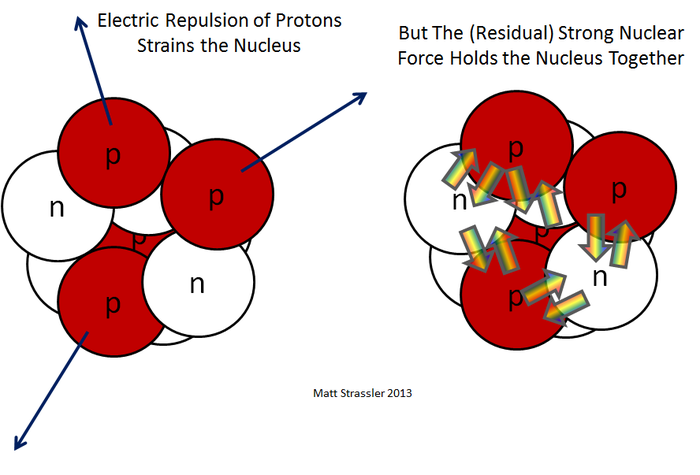The strong nuclear force, often defined as the omnipresent glue that binds protons and neutrons in atomic nuclei, operates at the subatomic level and is one of the four known fundamental forces of nature. While it plays a pivotal role in the stability and structure of matter as we understand it, the question of whether this formidable force is charge-dependent invites deeper scrutiny into the intricacies of nuclear interactions. In exploring this subject, we shall embark on a thorough examination of the characteristics, implications, and broader context of the strong nuclear force.
The strong nuclear force, or strong interaction, is primarily mediated by particles called gluons, which facilitate interactions between quarks, the fundamental constituents of protons and neutrons. This force is unique in that it asymptotically opposes the expansion of the universe at extremely small scales while exhibiting an unprecedented range of influence. Unlike electromagnetic forces, which are contingent on charge, the strong nuclear force operates independently of the electric charge carried by particles. This independence renders it compellingly unique within the tapestry of fundamental forces.
Intriguingly, the strong nuclear force is fundamentally tied to the color charge, a concept distinct and yet somewhat comparable to electric charge. Color charge arises from the quantum chromodynamics (QCD) framework, where quarks possess one of three types of color charge: red, green, or blue. This analogy may evoke the image of a painter on a canvas, requiring a delicate blend of hues to create a harmonious artwork. Similar to how the absence of a complementary color would result in a discordant piece, the strong force necessitates a balance of color charges to maintain the stability of nucleons.
Understanding the nature of this color charge reveals that, unlike electric charges, which either attract or repel based on their polarities, color charges engage in a complex interplay governed by confinement and asymptotic freedom. In essence, quarks are perpetually confined within larger particles, with their individual charges only experiencing freedom at extreme energies, such as those achieved in high-energy particle colliders. This design elucidates the phenomenon of confinement: a quark cannot exist independently; rather, it must coalesce with others to form baryons or mesons.
To further investigate whether the strong nuclear force exhibits charge-dependence, one must consider its characteristics beyond just quarks. It is essential to examine how it operates within protons and neutrons, both of which are baryons composed of three quarks. Despite the electric charge possessed by protons (positively charged) and neutrons (electrically neutral), the binding energy that the strong nuclear force generates is largely independent of their electric states. The energy levels of these baryons dictate the stability of nuclei, underscoring that it is the strong force—and not the electric charge—that governs their existence.
Moreover, the interactions observed within the strong force are richly textured, begetting a model reminiscent of a grand symphony. Each instrument—the baryons and mesons—plays a critical role in achieving the cohesive performance of the atomic nucleus. In this analogy, the conductor represents the gluons, orchestrating interactions that are seamless, harmonious, and profoundly influential. Tuning this ensemble to partake in the grand performance of nuclear stability illuminates the fact that the electric charge’s role is tangential, relegated to the shadows of the more impactful strong interaction.
Nonetheless, charge dependence does manifest in other contexts within particle physics, particularly when one observes the electromagnetic interactions proceeding concurrently in a nuclear environment. Whereas this interplay can influence the scattering of charged particles, it does not alter the foundational operand of the nucleus’s stability: the strong nuclear force. This complicated interplay of forces is akin to the nuances of a dance, where each partner brings a distinct flavor to the performance while the strong nuclear force remains the steadfast anchor beneath—the invisible force that ensures the dance is not disrupted.
The confluence of all these elements leads us to a rather captivating conclusion: while the strong nuclear force itself is not charge-dependent, its interactions must be contextualized within the grander framework that acknowledges the electric charges of protons and neutrons. This duality—the coexistence of electric and strong interactions—provides a profound perspective on the qualitative nature of the forces at play in the universe. It is the intricate tapestry woven through varying influences that gives rise to the nucleus’s stability.
In essence, the inquiry into the charge dependency of the strong nuclear force acts as a window into the unfathomable complexities embedded within the atomic and subatomic realms. This investigation illustrates how an initial inquiry can unfurl a series of rich intersections and symbiotic relationships among fundamental forces. Furthermore, the strong nuclear force, in its independence from charge, serves as a reminder of the layered structure of physical laws governing our universe—inviting both wonder and scholarly reflection.
Thus, the strong nuclear force’s operational independence from electric charge is a testament to its unique role within the fundamental forces of nature. It thrives in a landscape where subatomic interactions yield magnificent structures—atoms—forming the very building blocks of all matter. Appreciating these nuances not only enriches our understanding of nuclear physics but also deepens our philosophical engagement with the universe’s underlying truths.












